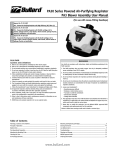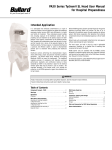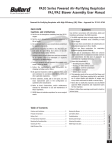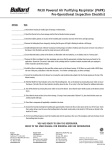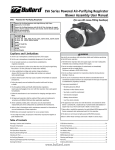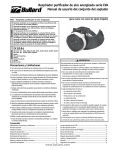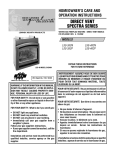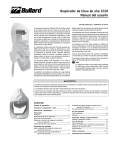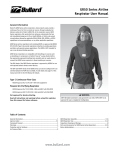Download Bullard PA30 Series User manual
Transcript
PA30 Series Powered Air-Purifying Respirator PA3/PA3IS Blower Assembly User Manual PA3 - Powered Air-Purifying Respirator with High Efficiency (HE) Filters (2) – Approval No. TC-21C-0773 PA3 - Powered Air-Purifying Respirator with PA3NBC cartridges (3) for chlorine, hydrogen chlorine, sulfur dioxide, chlorine dioxide, hydrogen fluoride, ammonia, methylamine, and particulates – Approval No. TC-23C-2236 PA3 - Powered Air-Purifying Respirator with OV-AG-HE Cartridges (3) for organic vapors, chlorine, hydrogen chloride, sulfur dioxide, chlorine dioxide or hydrogen fluoride and particulates – Approval No. TC-23C-2237 PA3IS - Powered Air-Purifying Respirator with High Efficiency (HE) Filters (2) - Appproval No. TC-21C-0796 PA3IS - Powered Air-Purifying Respirator with OV-AG-HE Cartridges (3) for organic vapors, chlorine, hydrogen chloride, sulfur dioxide, chlorine dioxide or hydrogen fluoride and particulates - Approval No. TC-23C-2307 PA3IS - Powered Air-Purifying Respirator with PA3NBC cartridges (3) for chlorine, hydrogen chlorine, sulfur dioxide, chlorine dioxide, hydrogen fluoride, ammonia, methylamine, and particulates – Approval No. TC-23C-2306 PA30 PAPR Cautions and Limitations A. Not for use in atmospheres containing less than 19.5% oxygen. B. Not for use in atmospheres immediately dangerous to life or health. C. Do not exceed maximum use concentrations established by regulatory standards. F. Do not use respirator if airflow is less than four cfm (115 lpm) for tight fitting face pieces or six cfm (170 lpm) for hoods and/or helmets. H. Follow established cartridge and canister change schedules or observe ESLI to ensure that cartridges and canisters are replaced before breakthrough. * I. Contains electrical parts that may cause an ignition in flammable or explosive atmospheres. J. Failure to properly use and maintain this product could result in injury or death. K. The Occupational Safety and Health Administration regulations require gas-proof goggles to be worn with this respirator when used against formaldehyde. L. Follow the manufacturer’s user instructions for changing cartridges and/or filters. M. All approved respirators shall be selected, fitted, used and maintained in accordance with MSHA, OSHA and other applicable regulations. N. Never substitute, modify, add or omit parts. Use only exact Bullard replacement parts in the configuration as specified by the manufacturer. O. Refer to User’s Instructions and/or maintenance manuals for information on use and maintenance of these respirators. P. NIOSH does not evaluate respirators for use as surgical masks. WARNING Use strictly in accordance with instructions, labels and limitations pertaining to the PA30 respirator. 1. The PA30 respirator does not supply oxygen. Use only in adequately ventilated areas containing at least 19.5% oxygen. 2. Do not use when concentrations of contaminants are immediately dangerous to life or health (IDLH). This term is defined in 29CFR 1910.134 (b). 3. Do not use these respirators for respiratory protection during abrasive blasting or clean up. 4. Do not use in circumstances where the airborne concentration level of contaminant exceeds maximum use concentration for this type of respirator as established by regulatory standards. 5. Leave area immediately if: • Breathing becomes difficult • Dizziness or other distress occurs • You taste or smell the contaminant • Unit becomes damaged • Voltage alarm activates 6. This apparatus must not be worn with the blower unit switched off. If the blower is switched off, a rapid build-up of carbon dioxide and depletion of oxygen may occur, which could result in death or serious injury. 7. Never alter or modify this respirator. Use only Bullard NIOSH -approved PA30 components and replacement parts for this respirator. Failure to follow these warnings could result in death or serious injury. Warnings and Limitations * This warning applies to the PA3 PAPR Blower, the PA3IS PAPR Blower is Factory Mutual (FM) approved for CLASS I DIV 1 Groups C, D CLASS II DIV 1 Groups E, F, G CLASS III DIV 1 Ta = -12ºC to 49ºC T4 1 www.bullard.com Table of Contents Table of Contents Warnings, Cautions and Limitations . . . . . . . . . . . . . . . . . . . . . . . . . . . . . . . . . . . . . . . . . . . . . . . . . . . . . . . . . . . . . . . . . . . . . . . . . . . . . . . . 1 Principle of Operation . . . . . . . . . . . . . . . . . . . . . . . . . . . . . . . . . . . . . . . . . . . . . . . . . . . . . . . . . . . . . . . . . . . . . . . . . . . . . . . . . . . . . . . . . . 3 Battery Pack . . . . . . . . . . . . . . . . . . . . . . . . . . . . . . . . . . . . . . . . . . . . . . . . . . . . . . . . . . . . . . . . . . . . . . . . . . . . . . . . . . . . . . . . . . . . . . . . . . 4 Pre-Operational Inspection . . . . . . . . . . . . . . . . . . . . . . . . . . . . . . . . . . . . . . . . . . . . . . . . . . . . . . . . . . . . . . . . . . . . . . . . . . . . . . . . . . . . . . 4 Mounting the Breathing Tube . . . . . . . . . . . . . . . . . . . . . . . . . . . . . . . . . . . . . . . . . . . . . . . . . . . . . . . . . . . . . . . . . . . . . . . . . . . . . . . . . . . . . 5 Checking Air Flow . . . . . . . . . . . . . . . . . . . . . . . . . . . . . . . . . . . . . . . . . . . . . . . . . . . . . . . . . . . . . . . . . . . . . . . . . . . . . . . . . . . . . . . . . . . . . . 5 Air-Purifying Elements . . . . . . . . . . . . . . . . . . . . . . . . . . . . . . . . . . . . . . . . . . . . . . . . . . . . . . . . . . . . . . . . . . . . . . . . . . . . . . . . . . . . . . . . . . 6 Mounting and Replacing Cartridges . . . . . . . . . . . . . . . . . . . . . . . . . . . . . . . . . . . . . . . . . . . . . . . . . . . . . . . . . . . . . . . . . . . . . . . . . . . . . . . .7 Donning the Blower . . . . . . . . . . . . . . . . . . . . . . . . . . . . . . . . . . . . . . . . . . . . . . . . . . . . . . . . . . . . . . . . . . . . . . . . . . . . . . . . . . . . . . . . . . . . 8 Low Battery Alarm . . . . . . . . . . . . . . . . . . . . . . . . . . . . . . . . . . . . . . . . . . . . . . . . . . . . . . . . . . . . . . . . . . . . . . . . . . . . . . . . . . . . . . . . . . . . . 8 Troubleshooting . . . . . . . . . . . . . . . . . . . . . . . . . . . . . . . . . . . . . . . . . . . . . . . . . . . . . . . . . . . . . . . . . . . . . . . . . . . . . . . . . . . . . . . . . . . . . . . 9 Cleaning and Storage . . . . . . . . . . . . . . . . . . . . . . . . . . . . . . . . . . . . . . . . . . . . . . . . . . . . . . . . . . . . . . . . . . . . . . . . . . . . . . . . . . . . . . . . . . . 9 NIOSH Approval Label . . . . . . . . . . . . . . . . . . . . . . . . . . . . . . . . . . . . . . . . . . . . . . . . . . . . . . . . . . . . . . . . . . . . . . . . . . . . . . . . . . . . . . . 10-11 Ordering Information . . . . . . . . . . . . . . . . . . . . . . . . . . . . . . . . . . . . . . . . . . . . . . . . . . . . . . . . . . . . . . . . . . . . . . . . . . . . . . . . . . . . . . . . . . 12 2 www.bullard.com PA30 Series Powered Air-Purifying Respirator PA3/PA3IS Blower Assembly User Manual PA3/PA3IS - Principle of Operation The PA30 Powered Air-Purifying Respirator (PAPR) System is supplied in six parts: 1. The blower assembly (Part No. PA3/PA3IS) which includes: The blower unit draws in ambient air through the cartridges. The purified air is blown into the wearer’s hood through the breathing tube. A flow indicator is provided to check that there is an adequate volume of air available to the wearer prior to use. The units are designed for use at temperatures from 10ºF to 120ºF (-12ºC to 49ºC). PA3BU Blower Unit or PA3ISBU Blower Unit PA1SB Belt or PA1DB Decon Belt PA1AFI Air Flow Indicator The system is designed to operate at a minimum air flow of approximately seven cubic feet of air per minute (210 liters per minute) in the hood under normal use. 2. The battery pack (Part No. PA3BP). One or two packs can be used. One fully charged pack will power the blower for approximately four to five hours. For Part No. PA3ISBP, one battery pack is used, lasting approximately seven hours. The battery pack(s) mount in compartment(s) on the back of the blower. One fully charged battery pack will power the blower for approximately four to five hours (PA3BU) or approximately seven hours (PA3ISBU). Two fully charged packs (PA3BU) will run for approximately eight hours. 3. The breathing tube, which is available in two different types and two lengths: PA1BT Hood Breathing Tube Assembly with Clamp (Standard Length) PA1BTXS Hood Breathing Tube Assembly with Clamp (Short Length) PA20LFBT Loose Fitting Facepiece Breathing Tube Assembly (Standard Length) PA20LFBTXS Loose Fitting Facepiece Breathing Tube Assembly (Short Length) 4. The cartridges are available in different types for most toxic contaminants. (See page 6 for a listing of the cartridges.) The types include High Efficiency particulate only, chemical cartridges for gases and vapors, and combination cartridges for gases, vapors and particulates. 5. The hood with headband suspension and/or hard hat, or loose fitting facepiece. The following hood models may be used with the PA3BU/PA3ISBU blower unit: The PA3BU/PA3ISBU is fitted with an alarm which will sound when voltage is low. CC20 and RT Series Airline Respirator NIOSH Approval No. TC-19C-154, Type C and TC-19C-412, Type C Most of the same headpieces approved for use with the CC20 and RT Series of supplied air respirators (SARS) are also approved for use with the PA30 Series of powered air-purifying respirators. CC20 and RT Series respirators provide a high level of respiratory protection and user comfort over long work periods, in a wide variety of hazardous environments. The CC20 and RT SAR air flow control devices and other components are described in the CC20 and RT Series User Instructions. Principle of Operation RT1/RT2 Hood with long inner and outer bib 20TJ Hood 20TIC Hood with Inner Bib 20TICH Hood for use with Bullard Hard Hat 20TICS Hood with Taped and Sealed Seams 20SIC Hood with Taped and Sealed Seams 20SICV Hood with Taped and Sealed Seams and CBRN-resistant PVC lens 20SICH Hood with Taped and Sealed Seams for use with Bullard Hard Hat 20SICVH Hood with Taped and Sealed Seams and CBRNresistant PVC lens for use with Bullard Hard Hat 20TPC Hood with Solvent Resistant Lens and Inner Bib 20TP Hood with Solvent Resistant Lens 20LFM Loose Fitting Facepiece Hood, Medium Size 20LFL Loose Fitting Facepiece Hood, Large Size 6. The Battery Charger: PA3SMC Quick Charger PA3GC Gang Charger PA3ISC Intrisically Safe Quick Charger PA3ISGC Intrinsically Safe Gang Charger 3 www.bullard.com pack in the nest. The charger light will now remain on (PA3BP) or turns red (PA3ISBP). Battery Pack A fully charged battery pack will power a blower unit to provide adequate air volume for the respirator for approximately four to eight hours for the PA3BU under normal working conditions, depending on whether one or two battery packs are used. A fully charged battery pack will power a blower unit to provide adequate air volume for the respirator for approximately seven hours for the PA3ISBU. To charge the battery pack, do the following: • Open the battery latch and remove the battery from the back of the blower. • When the light begins flashing again (PA3BP), or turns green (PA3ISBP) , remove the battery pack. Wait 15 seconds. Replace the battery pack in the nest again. The charger light will now remain on or turn red. The charger light will flash a third time (PA3BP), or turn green (PA3ISBP), indicating that the battery is fully charged. This procedure should also be followed after periods of prolonged storage. Without periodic charging, the nickel metal hydride batteries will lose up to 1%–2% of their charge per day. Allowing a battery to self-discharge during periods of prolonged storage will not damage the battery. WARNING DO NOT charge batteries in hazardous area. Pre-Operational Inspection Prior to each work shift, perform the following Pre-Operational Inspection to ensure proper operation and to insure that the unit is complete. 1. Belt Mounted Blower Unit, Part No. PA3BU/PA3ISBU • Check that the unit is clean and undamaged. • Inspect for deterioration, physical damage, and improper assembly. Figure 1 • Place each battery in the charging ports of the battery charger. Ensure that the battery contacts line up with the contacts in the charger port (see Figure 1). • Connect the battery charger to a 115-volt AC electrical outlet. Charge the battery pack for approximately eight hours. While the PA3BP battery is charging, the light on the charger will remain on. The charger light will flash when charging is complete. • Ensure that the correct filters/cartridges for the appropriate contaminant are properly mounted on the blower unit. Screw the cartridges into the ports until hand-tight. Consult the NIOSH approval label and your own in-plant safety professional if you have any questions as to the suitability and efficiency of the Air-Purifying Element. 2. Battery Pack • Check that the battery is not damaged. • Place the battery pack in the battery compartment on the blower by first engaging the tab on the pack under the lip on the edge of the compartment. Then close the latch. Place a second battery pack in the other compartment, if desired (PA3BU only). If only one battery is used, install the PA3BPC battery port cover over the unused port (for PA3BU). Battery Pack/Pre-Operational Inspection While the PA3ISBP battery is charging, the light on the cord will remain red. When the unit is charged, it will turn green. 4 Table-top gang chargers (Part No. PA3GC, with 5 ports, and Part No. PA3ISGC, with 6 ports) are also available. WARNING PA3BP battery packs MUST be used with PA3 blower units and PA3ISBP intrinsically safe battery packs MUST be used with PA3IS blower units. Interchanging these batteries with blowers may cause damage to the blower and battery AND the blowers will not operate as intended and may put the wearer at risk. Failure to follow these instructions may result in death or serious injury. 3. Hood with Suspension or Hard Hat, or Loose Fitting Facepiece Initial Charging Procedure with Quick Charger To ensure a full charge on a new battery pack, follow these important guidelines. These guidelines also apply to battery packs that have been in storage for extended periods of time. For new battery packs or packs that have been in storage for extended periods of time, follow the directions above under “Battery Pack”, and when the light begins to flash on the charger or turns green (PA3ISBP), do the following: • Remove the battery pack. Wait 15 seconds. Replace the battery www.bullard.com • The hood is constructed of either Tychem QC or Tychem SL. Depending on the model selected, it may be used with either a headband suspension or a hard hat. The loose fitting facepiece is constructed of Tychem QC and features an internal suspension. • All hoods and loose fitting facepieces are approved for use with the PA3BU and PA3ISBU Blower Units. • Inspect the hood or loose fitting facepiece for any physical damage. PA30 Series Powered Air-Purifying Respirator PA3/PA3IS Blower Assembly User Manual Mounting the Breathing Tube on the PA3BU/PA3ISBU Blower Ensure that a rubber gasket is in place in the breathing tube coupler on the blower unit. Screw one end of the breathing tube into the blower unit (hand tight is sufficient) (see Figure 2). Apply a light downward pressure to the Airflow Indicator to get a reasonable seal at the breathing tube end. Ensure that the air outlet holes in the Airflow Indicator tube are not blocked. Two hands may be used if preferred, one to hold the breathing tube and one to hold the Airflow Indicator. The position of the ball in the Airflow Indicator should be observed. If any part of the ball is below the PASS LINE on the Airflow Indicator, check for: • Blower malfunction. • Clogged or damaged Air-Purifying filter elements on the HE filters or the combination cartridges with HE filters. See “Mounting and Replacing Cartridges on the Blower Unit” on page 7. • Low voltage or battery malfunction. If the ball is completely above the PASS LINE on the Airflow Indicator, then the system is ready for use. NOTE Gasket Figure 2 On the PA3BU unit, due to the back-pressure of the ball, the Low Voltage Alarm may sound when a reading is being taken. If the ball bounces, let it stabilize, and then read the lowest point. When the blower passes the flow test, it is ready to use. Ensure that neither the breathing tube nor the filter is blocked. WARNING Ensure that the ON/OFF Switch is in the OFF position. Switch on the blower. If the Low Voltage Alarm sounds at this time, the battery needs to be recharged. See instructions on page 4 regarding properly charging the battery. NOTE On the PA3BU unit, the low voltage alarm will sound a short beep as the power switch is cycled on and off, indicating that the alarm is functioning properly. The alarm will sound continuously to indicate low voltage. With the blower switched ON and the filters/cartridges mounted, take the free end of the breathing tube in one hand, hold it upright and place the Airflow Indicator into the end of the tube (see Figure 3). Figure 3 Mounting the Breathing Tube/Checking Airflow Checking Airflow with the Airflow Indicator (PA1AFI) If the blower malfunctions during use in a hazardous area: DO NOT remove the respirator hood, blower or waist-belt while in the hazardous area. DO remain calm and LEAVE the hazardous area immediately. After reaching a hazard-free area, immediately remove the respirator. DO NOT use a blower that fails the flow test. Use ONLY Bullard cartridges which comply with and have the NIOSH approval label and which are appropriate for the contaminant. Failure to observe these warnings could result in death or serious injury. 5 www.bullard.com PA3BU/PA3ISBU Air-Purifying Elements Principle of Operation The following filter/cartridge protection classification applies when used with any of the hoods or loose fitting facepieces. In the following table “Quantity” refers to the number of filters/cartridges which must be attached to the blower unit to provide the required protection. Protection HE OV/CL/HC/SD/CD/HF/HE CL/HC/SD/CD/HF/FM/AM/MA/HE Filter/Cartridge Type Quantity PA3HE PA3OVAGHE PA3NBC* 2 3 3 NIOSH / ANSI Color Code for Cartridge Label Purple Yellow and Purple Olive Green and Purple *The PA3NBC cartridge provides protection for acid gases, formaldehyde, and ammonia and therefore is effective against a wide range of Toxic Industrial Chemicals. The High Efficiency (HE) Particulate Filter provides protection against airborne bacteria, viruses, and other particulates. Although not NIOSHapproved for use against the following contaminants, independent laboratories have tested and verified that the PA3NBC cartridge is effective against many chemical warfare agents and/or their recognized surrogates. These agents/surrogates are listed below. PA3NBC CARTRIDGE CHEMICAL WARFARE GAS PERFORMANCE TESTING Gas Challenge Test Concentration Flow Rate Breakthrough Concentration Time to Breakthrough DMMP 3000 mg/m3 50 lpm .04 mg/m3 >120 minutes* Sarin (GB) 4000 mg/m3 32 lpm .04 mg/m3 >120 minutes* Cyanogen Chloride (CK) 4000 mg/m3 32 lpm 8.0 mg/m3 30 minutes* Chloropicrin (PS) 15000 mg/m3 30 lpm 0.7 mg/m3 60 minutes Hydrogen Cyanide (AC) 5500 mg/m3 30 lpm 5.0 mg/m3 >30 minutes Tear Gas (CS) 23 mg/m3 64 lpm 0.4 mg/m3 >480 minutes Tear Gas (CN) 101 mg/m3 64 lpm 0.3 mg/m3 >480 minutes *These tests are part of the performance specifications for the C2A1 military canister. The PA3NBC Cartridge meets or exceeds the performance requirements of the C2A1 canister for these gases. HE particulate filters are 99.97% effective against all particulate aerosols. Filters and cartridges are supplied in quantities of six per box. The following abbreviations are approved by NIOSH to indicate the particulates, gases or vapors which are removed by the gas/vapor cartridges: Air-Purifying Elements CL CD HC SD FM AM MA OV HF HE Chlorine Chlorine Dioxide Hydrogen Chloride Sulfur Dioxide Formaldehyde Ammonia Methylamine Organic Vapors Hydrogen Fluoride High Efficiency Particulate Air Filter for Powered Air-Purifying Respirators WARNING Use only the cartridge described in the above table. Used/particulateladen cartridges must be changed as a set and not individually. All cartridges must be of the same type. Do not change cartridges while in a hazardous atmosphere. Incorrect cartridge selection will invalidate all performance statements and approvals for this equipment. Three (3) of the same type of cartridge must be used on the PA3BU/PA3ISBU blower unit, with the exception of the PA3HE filters which are used two (2) at a time, in conjunction with the PA3PG plug. DO NOT use the PA3PG plug to close off a port with any other cartridge type. The PA3NBC cartridges and PA3BU blower should only be used with the 20SICVH and 20SICV hoods.These hoods are made ofTychem SL, which has been tested by DuPont and shown to be effective against chemical warfare agents. These hoods also feature a press polished vinyl lens adequate for hospital preparedness applications. These respirators are not NIOSH-approved for use against chemical warfare agents. The respirator and cartridges should not be used beyond eight (8) hours after initial exposure to chemical warfare agents to avoid possibility of agent permeation. If liquid exposure is encountered, the respirator should not be used for more than two (2) hours. Follow established cartridge change schedules to ensure that cartridges are replaced before breakthrough occurs. Failure to follow these warnings could result in death or serious injury. 6 www.bullard.com PA30 Series Powered Air-Purifying Respirator PA3/PA3IS Blower Assembly User Manual Screw the air-purifying elements into the receptacles (see Figure 5) until the cartridge is hand tight. DO NOT OVERTIGHTEN. Mounting and Replacing Cartridges on the Blower Unit The useful life of a chemical cartridge for vapors and gases will vary with the concentration and nature of the contaminant, the breathing rate of the respirator wearer, and ambient temperature and humidity. The Occupational Safety and Health Administration (OSHA) regulations 29 CFR 1910.134 require that the employer must implement a change schedule when using Air-Purifying respirators for protection against gases and vapors, if there is no end-ofservice-life indicator on the cartridges. The change schedule must be based on objective data that will ensure that the cartridges are replaced before the end of their service life. Factors to consider include workplace conditions such as contaminant concentration, relative humidity, temperature, work activities, respirator use pattern (e.g., continuous or intermittent use), presence of other contaminants, potential for contaminant migration/desorption, health effects of the gas or vapor, and the presence of any warning properties. Contact Bullard for further information on change-out schedules. High efficiency particulate filters must be replaced when retained particles clog the filters and reduce air flow below acceptable levels, as indicated by testing with the Air Flow Indicator. See page 5. Figure 5 When using the two PA3HE filter cartridges, install the filter plug into one of the ports. DO NOT OVER-TIGHTEN (Figure 6). To Replace Cartridges Remove the air-purifying element from its packaging, and inspect for damage. If in doubt do not use. Check that the air-purifying element has not exceeded its “use-by” date and that the connecting thread is in good condition. Check that the air-purifying element is appropriate to the hazard. If in doubt consult your respirator program administrator or supervisor. Check that the threads in the blower unit port are in good condition and clear of contaminant. Figure 6 Check that the PA3BU/PA3ISBU blower ports have the rubber gasket seals present. Remove the air-purifying element seals (see Figure 4). Mounting the Cartridges Figure 4 7 www.bullard.com Donning the Blower and Respirator Prepare to don the blower, battery and hood in a safe, hazard-free area and do the following: Check that the cartridges are properly mounted on the blower unit. Prior to assembling the system, place the battery in the battery compartment on the back of the blower. Make sure that the correct battery is used in the apporpriate blower unit. One or two battery packs may be used (See instructions and warning on page 4). Fit the blower and belt around the user’s waist. With the blower at the rear of the user, adjust the belt for a comfortable fit. For All Headpieces: Attach the other end of breathing tube to blower unit by screwing adapters together. Remove any protective film covering the visor of the hood. Put on the belt and blower assembly and make any final adjustments to the belt as necessary, keeping the breathing tube and hood behind the head. Switch ON the blower. Place the hood on the head making any final adjustments to the fit as required at this time to ensure a comfortable and stable fit. Remove the belt and blower. WARNING Ensure that the cartridges used are suitable for the contaminant in question and are compatible with the PA3BU/PA3ISBU Blower Unit. WARNING The use of any cartridge not approved with the PA3BU/PA3ISBU blower units may put the user at risk and could result in death or serious injury. For Hoods: Insert the PA1BT Breathing Tube approximately 5 inches into the air entry sleeve at the rear of the hood being used (see Figure 7). Do not enter a hazardous area until you are sure that the blower and hood are fully operational and the blower is running. The user should periodically leave the hazardous area to check the airflow through the system. If the PA3BU/PA3ISBU voltage Alarm should sound, or if the user experiences any difficulty in breathing, or senses any taste or any odors from the hazard, the user should leave the hazardous area immediately. Failure to observe these warnings could result in death or serious injury. PA3BU/PA3ISBU Low Voltage Alarm Both the PA3BU and PA3ISBU Blower units are equipped with a Low Voltage Alarm. This device will activate if the battery voltage is below acceptable levels. The PA3BU Low Voltage Alarm is an electronic 77 dba beep. The PA3ISBU Low Voltage Alarm is a mechanical pulsing of the blower. In either case, the alarm is internal to the blower and the sound will be carried up the breathing tube into the hood. Sounding of the alarm indicates that insufficient airflow may be imminent. The user should immediately do the following: Leave the hazard area, remove the headpiece, disconnect the breathing tube from the hood and check the airflow with the airflow indicator (see page 5). Donning the Blower/Low Battery Alarm Figure 7 8 Install nylon clamp S18051 over air entry sleeve and breathing tube, inserting clamp locks through two holes in plastic anchor plate that is sewn into hood (RT Hoods DO NOT have a plastic anchor plate.). If the airflow indicator indicates insufficient airflow, the battery should be fully charged (see “Battery Pack” on page 4), and/or the filter/cartridge should be replaced. The PA3BU/PA3ISBU Low Voltage Alarm must not be solely relied upon as an indication of a low air flow condition. Only the Air Flow Indicator should be utilized for checking for adequate air flow, as required by NIOSH. Engage clamp locks and squeeze together until tight. For Loose Fitting Facepieces: If the loose fitting facepiece hood is being used, insert the bayonet connector of the PA20LFBT Breathing Tube into the hood connector and turn clockwise until it locks in place (see Figure 8). Figure 8 www.bullard.com NOTE The PA3BU/PA3ISBU blower is provided with a circuit to protect the battery. It will not allow the battery to be discharged below a safe voltage for the cells, regardless of airflow, without the Alarm sounding. When the Low Voltage Alarm sounds and the filter cartridges are not clogged, the battery should be recharged to protect the battery and thereby prolong the working life of the unit. If the ball in the Airflow Indicator is BELOW or PARTLY BELOW the PASS LINE with a fully charged battery, the filter cartridges may need to be changed. PA30 Series Powered Air-Purifying Respirator PA3/PA3IS Blower Assembly User Manual Troubleshooting The following guide will enable you to locate and correct malfunctions: Malfunction Possible Cause Solution Low Voltage Alarm is sounding, but Airflow Indicator shows adequate air flow Low Voltage Air inlet to hood is twisted or constricted, or breathing tube inserted incorrectly Re-charge battery. Remove, inspect, and reinsert PA1BT Breathing Tube approximately 5" into hood inlet. No/low airflow into covering (Alarm sounding for low voltage) Clogged/damaged air-purifying filter element Replace the filter cartridge. Battery low Re-charge battery. Blower malfunction Replace blower. Breathing tube or hood damaged Replace breathing tube and/or hood. Equipment damaged or filter needs to be replaced Leave hazardous area immediately and check equipment. Smell or taste contaminant Replace filter. If the problem persists and no damage is found, return equipment for repair. Blower unit does not run for full service life PA3 (8-10 hours with 2 battery packs; 4-5 hours with 1 battery pack) Low airflow See above. Improper initial charge Prolonged storage of unit not on charger Review “Initial Charging Procedure” on page 4. PA3IS (Approximately 7 hours with 1 battery pack) Cleaning Storage WARNING The storage temperature should be between 32º F to 90º F (0º C to 32º C) with humidity less than 90% RH. Consult the CC20/PA30 Series Tychem Hood User Manual for storage instructions on hood components. Ensure water does not enter cartridges. Replace wet cartridges. DO NOT use gasoline, organic-based solvents, or chlorinated degreasing fluids (such as trichloroethylene) as they will cause damage. DO NOT immerse the equipment in water or other cleaning fluid as this may cause contamination in the breathing tube and blower interior that will be difficult to remove. Failure to observe the instructions and warnings in this manual invalidates all performance statements and approvals for this equipment and could result in death or serious injury. Once cartridges have reached the end of their useful life, discard in accordance with federal, state, and local guidelines, and in conformance with plant safety regulations. Use a lint-free cloth moistened in a mild solution of soap and warm water to clean the outer surface of the equipment. Consult the CC20/RT Series Tychem Hood User Manual for cleaning instructions for the hood components. www.bullard.com Troubleshooting/Cleaning and Storage Avoid contaminant entry into the breathing tube, as this will compromise respiratory protection and could result in death or serious injury. Consult your local safety professional if you suspect that contaminant has entered the breathing tube. When cleaning the equipment, do the following: When the apparatus is completely dry, store in a clean, dry area, away from direct sunlight and sources of direct heat. 9 Cautions and Limitations Not for use in atmospheres containing less than 19.5% oxygen. Not for use in atmospheres immediately dangerous to life or health. Do not exceed maximum use concentrations established by regulatory standards. Do not use this respirator if airflow is less than four cfm (115 lpm) for tight-fitting facepieces or six cfm (170 lpm) for hoods and/or helmets. H. Follow established cartridge and canister change schedules or observe ESLI to ensure that cartridges and canisters are replaced before breakthrough occurs. I. Contains electrical parts that may cause an ignition in flammable or explosive atmospheres. J. Failure to properly use and maintain this product could result in death or serious injury. A. B. C. F. 2 1 X PA3HE X X X X X X X X X X X ACCESSORIES X X X X X X X X X X X X X X X X X X X X X X X X X X X X X X X X X ABCFHIJLMNOP ABCFHIJLMNOP ABCFIJLMNOP CAUTIONS AND LIMITATIONS2 L. Follow the manufacturer’s instructions for changing cartridges and/or filters. M. All approved respirators shall be selected, fitted, used, and maintained in accordance with MSHA, OSHA, and other applicable regulations. N. Never substitute, modify, add, or omit parts. Use only exact replacement parts in the configuration as specified by the manufacturer. O. Refer to users instructions, and/or maintenance manuals for information on use and maintenance of these respirators. P. NIOSH does not evaluate respirators for use as surgical masks. X X X Protection HE - High Efficiency Particulate Air Filter for Powered Air-Purifying Respirators AM - Ammonia CD - Chlorine dioxide CL - Chlorine FM - Formaldehyde HC - Hydrogen chloride HF - Hydrogen fluoride MA - Methylamine OV - Organic Vapors SD - Sulfur Dioxide PA3BU RT1 RT2 20TJN 20TICN 20SICN 20TICSN 20TICH 20SICH 20TPN 20TPCN 20LFM 20LFL 20SICVN 20SICVH 20TG 20RT 3000 3000R 51WHP 51WHR PA1BT PA1BTXS PA20LFBT PA20LFBTXS 21C-0773 HE X X X X X X X X X X X X X X X X X X X X X X X X 23C–2236 AM/CL/HC/MA/FM/HF/SD/CD/HE X X X X X X X X X X X X X X X X X X X X X X 23C-2237 OV/CL/HC/HF/SD/CD/HE X X X X X X X X X X X X X X X X X X X X X X PA3NBC PROTECTION1 PA3OVAGHE TC- PA1AFI AIR ALTERNATE ALTERNATE ALTERNATE ALTERNATE FLOW SUSPENSION/ BREATHING BLOWER UNIT FILTER CARTRIDGE INDICATOR BATTERY TUBE BELT HARD HAT Cynthiana, KY 41031 USA 1-800-827-0423 Bullard PA3BP ALTERNATE HOOD ASSEMBLIES RESPIRATOR COMPONENTS This respirator is approved only in the following configurations: PA30 Powered Air-Purifying Respirator PA1SB PA30 Approval Label PA1DB NIOSH Approval Label PA3SMC PA3PG PA1EB PA1DEB 20NC ES42 20LCL 20LC PA3BPC 20SLBTC 10 Not for use in atmospheres containing less than 19.5% oxygen. Not for use in atmospheres immediately dangerous to life or health. Do not exceed maximum use concentrations established by regulatory standards. Do not use this respirator if airflow is less than four cfm (115 lpm) for tight-fitting facepieces or six cfm (170 lpm) for hoods and/or helmets. H. Follow established cartridge and canister change schedules or observe ESLI to ensure that cartridges and canisters are replaced before breakthrough occurs. J. Failure to properly use and maintain this product could result in death or serious injury. A. B. C. F. 2 NIOSH Approval Label www.bullard.com Cautions and Limitations Protection HE - High Efficiency Particulate Air Filter for Powered Air-Purifying Respirators AM - Ammonia CD - Chlorine dioxide CL - Chlorine FM - Formaldehyde HC - Hydrogen chloride HF - Hydrogen fluoride MA - Methylamine OV - Organic Vapors SD - Sulfur Dioxide 1 RT1 RT2 20TJN 20TICN 20SICN 20TICSN 20TICH 20SICH 20TPN 20TPCN 20LFM 20LFL 20SICVN 20SICVH 20TG 20RT 3000 3000R 51WHP 51WHR PA1BT PA1BTXS PA20LFBT PA20LFBTXS X X X PA3PG X PA3HE X PA3NBC X X PA3OVAGHE PA3ISBU X X X X X X X X X ACCESSORIES X X X X X X X X X ABCFJLMNOP X X X X X X X X X ABCFHJLMNOP X X X X X X X X X ABCFHJLMNOP CAUTIONS AND LIMITATIONS2 L. Follow the manufacturer’s instructions for changing cartridges and/or filters. M. All approved respirators shall be selected, fitted, used, and maintained in accordance with MSHA, OSHA, and other applicable regulations. N. Never substitute, modify, add, or omit parts. Use only exact replacement parts in the configuration as specified by the manufacturer. O. Refer to users instructions, and/or maintenance manuals for information on use and maintenance of these respirators. P. NIOSH does not evaluate respirators for use as surgical masks. 21C-0796 HE X X X X X X X X X X X X X X X X X X X X X X X X 23C-2306 AM/CL/HC/MA/FM/HF/SD/CD/HE X X X X X X X X X X X X X X X X X X X X X X X X X X X X X X X X X X X X X X X X X X X X X X X X 23C-2307 OV/CL/HC/HF/SD/CD/HE PA1AFI PROTECTION1 PA3ISBP TC- PA1SB AIR ALTERNATE ALTERNATE ALTERNATE SUSPENSION/ BREATHING BLOWER PORT ALTERNATE FLOW HARD HAT UNIT PLUG FILTER CARTRIDGE INDICATOR BATTERY TUBE BELT ASSEMBLY Cynthiana, KY 41031 USA 1-800-827-0423 Bullard PA1DB ALTERNATE HOOD ASSEMBLIES RESPIRATOR COMPONENTS This respirator is approved only in the following configurations: PA30IS Powered Air-Purifying Respirator PA3ISC PA1EB PA1DEB 20NC ES42 20LCL 20LC 20SLBTC PA30IS Approval Label PA30 Series Powered Air-Purifying Respirator PA3/PA3IS Blower Assembly User Manual 11 Head Protection Respiratory Protection Fire and Rescue Safety Thermal Imaging Ordering Information CATALOG NUMBER CATALOG NUMBER DESCRIPTION Respirator Assemblies PA30LFLSB 20LFL Loose-Ftting Facepiece System with Standard Comfort Belt PA30TJB 20TJ Single Bib Hood System with Standard Comfort Belt PA30TICSB 20TIC Double Bib Hood System with Standard Comfort Belt PA30TICHSB 20TICH Double Bib Hood for Hard Hat System with Standard Comfort Belt PA30SICSB 20SIC Double Bib Saranex Coated Hood System with Standard Comfort Belt PA30SICHSB 20SICH Double Bib Saranex Coated Hood For Hard Hat System with Standard Comfort Belt PA30TPSB 20TP Single Bib Hood for Painting System with Standard Comfort Belt PA30TPCSB 20TPC Double Bib Hood for Painting System with Standard Comfort Belt PA30TICSSB 20TICS Extra Long Double Bib Hood System with Standard Comfort Belt PA30RTISB RT1 Headband Free Extra Large Lens Double Bib Hood System with Standard Comfort Belt PA30RT2SB RT2 Headband Free Extra Large Lens Double Bib Saranex Coated Hood System with Standard Comfort Belt NOTE For Intrinsically Safe Blower, add “IS” to Part Number above Example: PA30ISLFLSB Blower Assemblies PA3 Tri-filter blower unit (ivory color) with low voltage alarm, battery, battery port cover, and belt. Breathing tube, replacement battery and charger sold separately. PA3IS Tri-filter blower unit (blue color), intrinsically safe with low voltage alarm, battery, and belt. Breathing tube, replacement battery and charger sold separately. Battery Chargers PA3SMC Quick charger for PA3BP (2 ports) PA3GC Table top gang charger for PA3BP (5 ports) PA3ISC Quick charger for PA3ISBP (1 port) PA3ISGC Table top gang charger (6 ports) Replacement Cartridges PA3HE HE (6 per box) PA3OVAGHE OV/CL/HC/SD/CD/HF/HE (6 per box) PA3NBC CL/HC/SD/CD/HF/FM/AM/MA/HE (6 per box) Respirator Hoods Basic style hood, for use with headband suspension 20TJ Tychem QC with 20TG headband suspension 20TJN Tychem QC, no headband suspension 20TP Tychem QC, with solvent-resistant polyester lens, 20TG headband suspension (CC20 only) 20TPN Tychem QC with solvent-resistant polyester lens, no suspension (CC20 only) Hood with inner bib, for use with headband suspension 20TIC Tychem QC, with 20TG headband suspension 20TICN Tychem QC, no headband suspension 20TPC Tychem QC, with solvent-resistant polyester lens, 20TG headband suspension (CC20 only) 20TPCN Tychem QC with solvent-resistant polyester lens, no suspension (CC20 only) Hood with inner bib, for use with Bullard hard hat 20TICH Tychem QC, hard hat not included 20SICH Tychem SL, with taped and sealed seams,hard hat not included 20SICVH Tychem SL, with taped and sealed seams and CBRN-resistant PVC lens, hard hat not included Bullard 1898 Safety Way Cynthiana, KY 41031-9303 Toll free: 877-BULLARD (285-5273) Tel: 859-234-6616 Fax: 859-234-8987 www.bullard.com Bullard GmbH Lilienthalstrasse 12 53424 Remagen Germany phone: 0049-2642 999980 fax : 0049-2642 9999829 www.bullardextrem.com DESCRIPTION Hood with inner bib and long outer bib, for use with headband suspension 20TICS Tychem QC with taped and sealed seams, and 20TG headband suspension 20TICSN Tychem QC with taped and sealed seams, no headband suspension 20SIC Tychem SL, with taped and sealed seams, and 20TG headband suspension 20SICN Tychem SL, with taped and sealed seams, no headband suspension 20SICVN Tychem SL, with taped and sealed seams and CBRN-resistant PVC lens, no headband suspension Loose Fitting Facepieces with Sewn-In Suspension 20LFM Tychem QC, facial seal, medium 20LFL Tychem QC, facial seal, large Accessory Items for All Hoods 20LC Mylar lens covers (25/pkg) 20LCL Mylar lens covers (25/pkg) Headband Suspensions and Hard Hats 20TG Standard headband suspension 20RT Sure-Lock® ratchet headband suspension 3000 Hard hat with standard suspension, white 3000R Hard hat with ratchet suspension, white 51WHP Hard hat with standard suspension, white 51WHR Hard hat with ratchet suspension, white Accessories for Headbands Suspension and Hard Hats ESULTRA Standard replacement suspension for 3000 hard hat ESRTSL Replacement ratchet suspension for 3000R hard hat RS4PC Standard replacement suspension for 51WHP hard hat RS4RC Replacement ratchet suspension for 51WHR hard hat 20NC Chin strap for 20TG and 20RT headband suspension ES42 Chin strap for 3000 and 5100 hard hats Replacement Parts and Accessories PA1SB PA1DB PA1EB PA1DEB PA1AFI PA3BU PA3ISBU PA1BT PA1BTXS PA20LFBT PA20LFBTXS PA1BTS PA3BP PA3ISBP S18051 PA3PG PA3BPC Standard belt Decon belt Extension standard belt kit Extension decon belt kit Air flow indicator Blower housing unit, motor and impeller Blower housing unit (I.S. version), motor and impeller Hood breathing tube assembly; includes tube and clamp; standard length Hood breathing tube assembly; includes tube and clamp; short length Loose fitting facepiece breathing tube assembly; standard length Loose fitting facepiece breathing tube assembly; short length Breathing tube/cartridge seal 4 hour battery pack 7 hour battery pack (Intrinsically Safe) Breathing tube clamp Plug for blower port Battery port cover Bullard Asia Pacific Pte. Ltd. Cisco Centre 20 Jalan Afifi, #08-03 Singapore 409179 Tel: (65) 6745-0556 Fax: (65) 6745-5176 www.bullard.com ISO 9001 certified ©2006 Bullard. All rights reserved. “It’s Your Life and You’re Worth It” is a trademark of Bullard. Tychem is a registered trademark of E.I. DuPont de Nemours & Company. 6081506374(0806)












